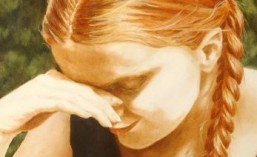These are my class notes from our egg tempera demo in the Survey of Painting Materials class. Enjoy!
The lecithin of the egg yolk is the emulsion binder for egg tempera. (More info on egg yolks here: http://www.joepastry.com/2013/egg-yolk/ or http://imaginationstationtoledo.org/content/2011/04/the-anatomy-of-a-chicken-egg/
- Separate the egg yolk from the white
- Roll the yolk around in your hand or a towel to get any remaining binder off (dilutes the binder)
- Hold onto the yolk “sack” to squeeze out as much of the insides of the yolk as you can
- The fresher the egg, the better; the older the egg gets, the more it loses lecithin and protein
- Add about 1 tsp of water to your egg yolk
- If you want your paint to dry faster, use less water; slower, use more water
- 1/2 tsp to 2 tsp is usually a good range
- never use more than 2 tsp, the paint won’t bind properly
- Add 1 drop of vinegar to preserve the egg in the refrigerator
Before adding pigment, it’s best to let the egg/water/vinegar mixture rest for about 10-15 minutes to bind together properly. If stored in a good cold fridge, the mixture can last up to a week, week and a half. Trust your nose! Give it a good whiff every time you take it out. If it smells funky, it’s time to make a new mixture. The fresher the egg the better, preferably organic. It really makes a difference! The binding qualities are better with fresher eggs.
Our professor recommended this book, which I will hopefully obtain a copy of soon: The Practice of Tempera Painting: Materials and Methods by Daniel V. Thompson
Alessandro Botticelli, Giotto di Bondone & Andrew Wyeth are key egg tempera painters to study.
The benefit of egg tempera over oil paint is that the color doesn’t fade or yellow over time (the egg protects from UV light). The yellow of the yolk goes away as the paint dries, but the colors stay clear & fresh.
Some artists like to lay down a verdaccio underpainting first (usually a greenish-grey tinted painting – the color is a mixture of black and yellow ochre or green oxide). For an example, please see my earlier post about the verdaccio underpainting I did for my Wyeth study: Verdaccio underpainting.
Verdaccio underpaintings help set the composition of the image and are especially helpful with portraiture, as the greenish undertone compliments the warmer skin tones as they are thinly layered over the top. Botticelli built up many layers of color in this way, green underneath and warm tones over top. He even painted freckles and other marks on the skin and then added a couple more layers of color to help make the freckles feel as if they were truly part of the skin tone. This is called “pedimenté” (not sure of spelling) – when you are able to see changes in the layers underneath the top layer of the painting.
For underpainting with egg tempera, you can use:
- Watercolors
- Gouache
- Water-based ink
- Dry pigments
Then, basically, just slowly build up the layers of the painting, allowing each layer time to cure in between, so you don’t pick up color from the lower layers or cause chipping if the previously painted layer gets too wet and brittle. It’s good to start with darker or mid-tone colors first, and build up to lights. The lights are a little more translucent, so you can still see some of the color below coming through.
Other techniques that can help the egg tempera look more realistic and add depth:
- Occasionally use dry brush to block in hair and areas that need to pick up more light
- Scratch through upper layers down to the underpainting to hint at really fine hairs or lines
- You can actually use white with egg tempera in the final layers, unlike watercolor, since egg tempera is more opaque. If the egg tempera mixture ratio is good, you can scratch through the layers. If it has too much water, it will act more like watercolor and won’t scratch away.
When you are done, apply a couple of thin layers of the egg yolk, vinegar and water mixture (allowing dry time in between) to even out any matte vs. shiny spots & to seal in the color. When those layers are completely dry, buff with a really soft, lint free rag, to give the piece a final luminous sheen.
Other valuable sites:
